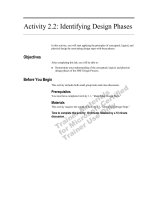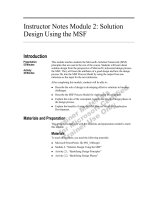2 2 casing design
Bạn đang xem bản rút gọn của tài liệu. Xem và tải ngay bản đầy đủ của tài liệu tại đây (218.5 KB, 24 trang )
Network of Excellence in Training
Casing Design Principles
© COPYRIGHT 2001, NExT.
All Rights Reserved
Casing Design Principles
• Lecture Contents;
– Lecture Objectives,
– Definitions,
– Casing Design Criteria,
• Collapse,
• Burst,
• Tension.
2
© COPYRIGHT 2001,
.
All Rights Reserved
Casing Design Principles
• Lecture Objectives
– At the end of this lecture YOU will be able to:
• Be familiar with the design criteria that is taken into
consideration when a casing string is to be designed with
respect to:
– Collapse,
– Burst,
– Tension.
• List the design safety factors.
3
© COPYRIGHT 2001,
.
All Rights Reserved
Casing Design Principles
• Definition;
– Casing design involves the determination of factors
which influence the failure and the selection of the most
suitable casing grades and weights for specific
operations,
– The casing program should also reflect the completion
and production requirements,
– A good knowledge of the stress analysis and the ability to
apply it are necessary for the design of casing strings.
4
© COPYRIGHT 2001,
.
All Rights Reserved
Casing Design Principles
• Definition;
– The end product of such design is a pressure vessel capable of withstanding the expected internal and external pressures and axial loading,
– Hole irregularities further subject the casing to bending forces which must be considered during the selection of casing grades,
– In general, the cost of a given casing grade is proportional to its weight, the heaviest weight being the most expensive,
– And hence the designer must ensure the cheapest and the best quality.
5
© COPYRIGHT 2001,
.
All Rights Reserved
Casing Design Principles
• Design Criteria;
– Casing design criteria are:
• Collapse,
• Burst,
• Tension (weight, bending & shock load),
• Triaxial,
• Other service loads (Corrosion, wear, H2S, High
Temperature etc.)
6
© COPYRIGHT 2001,
.
All Rights Reserved
Casing Design Principles
• Design Criteria;
– Collapse Pressure:
• This pressure originates from the column of mud used to drill the hole and acts on the outside of the empty casing,
• Since the hydrostatic pressure of a column of mud increases with depth collapse pressure is highest at the bottom and zero
at top.
Pressure
Pressure
7
© COPYRIGHT 2001,
.
All Rights Reserved
Casing Design Principles
• Design Criteria;
– Basic Collapse Assumptions:
• Casing is empty due to lost circulation
at shoe or at TD,
• Internal pressure inside casing is zero,
CSD
• External pressure is caused by mud in
which casing was run in,
• No cement outside casing.
TD
8
© COPYRIGHT 2001,
.
All Rights Reserved
Casing Design Principles
• Design Criteria;
– Collapse (C):
• C = mud density x depth x acceleration due to gravity,
• C = ρgh,
• C = 0.052 ρ h
• Collapse pressure at shoe: External pressure - Internal
pressure
• Collapse pressure at surface = 0
9
© COPYRIGHT 2001,
.
All Rights Reserved
Casing Design Principles
• Design Criteria;
– Burst:
• The burst criterion is normally based on the maximum
formation pressure resulting from a kick during the drilling of
the next hole section.
Pressure
10
© COPYRIGHT 2001,
.
All Rights Reserved
Casing Design Principles
• Design Criteria;
– Burst:
• Gas to Surface:
– This is an extreme case,
– For added safety it is assumed that the
influx fluid (gas) displaces the entire
drilling mud,
CSD
– This will subject the inside casing to
bursting effects of formation pressure.
TD
11
© COPYRIGHT 2001,
.
All Rights Reserved
Casing Design Principles
• Design Criteria;
– Burst:
• Gas to Surface:
– At the top of the hole, the external pressure due to hydrostatic
head of mud is zero and the internal pressure must be supported
entirely by the casing body,
– Therefore, the burst pressure is highest at the top and lowest at
the casing shoe where internal pressure is resisted by the
external pressure originated from fluids outside the casing.
12
© COPYRIGHT 2001,
.
All Rights Reserved
Casing Design Principles
• Design Criteria;
– Burst:
• Gas to Surface:
– In conventional casing design, it is customary to assume a gas
kick, thereby anticipating the worst possible type of a kick,
– The gas gradient is of the order of 0.1 psi/ft. This gradient
causes a small decrease in formation pressure as gas rises up
the well,
– Casing seat should be selected so that gas pressure at the casing
shoe is less than the formation breakdown at the shoe,
– In exploration wells where reservoir pressure is not known,
formation pressure from the next openhole section is calculated
form the maximum mud weight.
13
© COPYRIGHT 2001,
.
All Rights Reserved
Casing Design Principles
• Design Criteria;
– Burst:
• Burst pressure at surface (B1) = Pf - G x TD,
• Calculate the internal pressure (Pi) at the shoe using the
maximum formation pressure at next hole TD, assuming the
hole is full of gas:
– Pi = Pf - G x (TD – CSD)
– Pe = 0.465 x CSD,
• Burst pressure at shoe (B2) = Pi - Pe
– B2 = Pf - G x (TD - CSD) - 0.465 x CSD.
14
© COPYRIGHT 2001,
.
All Rights Reserved
Casing Design Principles
• Design Criteria;
– Example:
•
•
•
•
•
•
•
•
9 5/8” casing,
CSD = 5000 ft,
TD = 10000 ft,
Pf = 5000 psi,
Mud for 9 5/8” casing = 10 ppg.
Collapse at shoe = 10 * 0.052 * 5000 = 2600 psi,
Burst at surface = 5000 - ( 0.1 * 10000 ) = 4000 psi,
Burst at shoe = { 5000 - ( 0.1* [ 10000 - 5000] ) } - { 0.465 * 5000}
= 4500 - 2325 = 2175 psi,
• Selection L80 40lb/ft, B = 5750 psi, C = 3090 psi.
15
© COPYRIGHT 2001,
.
All Rights Reserved
Casing Design Principles
• Design Criteria;
– Tension:
• Most of axial tension arises from the weight of the casing
itself,
• Other tension loadings can arise due to:
– Bending,
– Drag,
– Shock loading and during pressure testing of casing.
• In casing design, the uppermost joint of the string is
considered the weakest in tension as it has to carry the total
weight of the casing string.
16
© COPYRIGHT 2001,
.
All Rights Reserved
Casing Design Principles
• Design Criteria;
– Tension:
• Tensile forces are determined as follows:
– Calculate weight of casing in air (positive value) using true
vertical depth,
– Casing air weight = casing weight (lb/ft) * hole depth (TVD),
– Calculate buoyancy for (negative value),
– BF = Pe (Ae - Ai) for open-ended casing,
– BF = Pe Ae - Pi Ai for closed casing
17
© COPYRIGHT 2001,
.
All Rights Reserved
Casing Design Principles
• Design Criteria;
– Tension:
• Pressure area method
Ae
Ae
Ai
Ai
Pi
18
Pi
Pi
Open-ended CSG
Pe
Closed CSG
© COPYRIGHT 2001,
.
All Rights Reserved
Casing Design Principles
• Design Criteria;
– Tension:
• Example:
– 20”, ID = 18.71 in, 133 lb/ft, open-ended,
– CSD = 2800 ft, Mud = 10 ppg.
• Solution using pressure-area method;
– Air weight = 2800 ft * 133 lb/ft = 372,400 lbs,
– B Force = Pe (Ae - Ai) for open-ended casing,
– BF = 0.052 * 10 * 2800 (314.16 - 274.94) = 57,104 lb,
– B weight = 372,400 - 57,104 =315,295 lbs.
19
© COPYRIGHT 2001,
.
All Rights Reserved
Casing Design Principles
• Design Criteria;
– Tension:
• Solution using Buoyancy Factor method;
– Air weight = 2800 ft * 133 lb/ft = 372,400 lbs,
– BF = ( 1- 10/65.4 ) = 0.847
– BW = 372,400 * 0.847 = 315,422 lb (315,652 lb from pressure
area method).
20
© COPYRIGHT 2001,
.
All Rights Reserved
Casing Design Principles
• Design Criteria;
– Tension:
• Calculate bending force in deviated wells (positive value),
– Bending force = 63 Wn * OD * Θ,
Wn = wt of casing (lb/ft) positive force,
Θ = dogleg severity (deg/100ft), (use 2deg/100 as an average)
• Calculate pressure testing force:
– The casing should be tested to the maximum pressure for which it
has been designed
– Force due to pressure = π/4 (ID2) * test pressure.
21
© COPYRIGHT 2001,
.
All Rights Reserved
Casing Design Principles
• Design Criteria;
– Safety Factors:
• Collapse
:
1.0,
• Burst
:
1.1,
• Tension
:
1.3 - 1.6
22
© COPYRIGHT 2001,
.
All Rights Reserved
Casing Design Principles
• Now You should be able to:
– Be familiar with the design criteria that is taken into
consideration when a casing string is to be designed with
respect to:
• Collapse,
• Burst,
• Tension.
– List the usable design safety factors.
23
© COPYRIGHT 2001,
.
All Rights Reserved
Network of Excellence in Training
Casing Design Principles
End of Lecture
© COPYRIGHT 2001, NExT.
All Rights Reserved









